Quantifying the Environmental Impacts of Cookstove Transitions: A Societal Exergy Analysis Based Model of Energy Consumption and Forest Stocks in Honduras
Abstract
1. Introduction
1.1. The Importance of Energy
1.2. Impacts of Primary Solid Biofuel Consumption
1.2.1. Health
1.2.2. Energy Cost
1.2.3. Environmental Costs
1.2.4. Economic Costs
1.3. Interactions between the United Nations Sustainable Development Goals and PSBs
- Goal 3: “ensure healthy lives and promote well-being for all at all ages.”
- Goal 7: “ensure access to affordable, reliable, sustainable and modern energy for all.”
- Goal 12: “ensure sustainable consumption and production patterns.”
- Goal 15: “protect, restore, and promote sustainable use of terrestrial ecosystems, sustainably manage forests, combat desertification, and halt and reverse land degradation and halt biodiversity loss.” [13]
1.4. Research Aim and Structure
2. Honduras as a Case Study
2.1. Honduran Primary Solid Biofuel Consumption
2.2. Residential Cooking in Honduras
3. Methods and Data
3.1. Historical Analysis
3.1.1. Societal Exergy Analysis in Honduran Residential Sector
3.1.2. Allocation of Residential Final Energy to End Uses
3.2. Energy Forecast
3.2.1. Forecasting Useful Energy Consumption
3.2.2. Fuel Production Efficiency
3.2.3. Predicting Primary and Final Energy
Current Technology (CT)
Improved Efficiency (IE)
Fuel Switching (FS)
3.2.4. Forecasting CO Emissions
4. Results and Discussion
4.1. Useful Energy Model
4.2. Primary Energy Consumption from Residential Cooking
4.3. Reduction in Forest Stocks
4.4. CO Emissions
4.5. Limitations and Future Work
5. Conclusions
Supplementary Materials
Author Contributions
Funding
Acknowledgments
Conflicts of Interest
Abbreviations
| CT | Current Technologies |
| CO | Carbon Dioxide |
| ECC | Energy Conversion Chain |
| FS | Fuel Switching |
| GHG | Greenhouse Gas |
| HAP | Household Air Pollution |
| HDI | Human Development Index |
| IE | Improved Efficiency |
| IEA | International Energy Agency |
| IPCC | Intergovernmental panel on climate change |
| LPG | Liquid Petroleum Gas |
| MTH | Medium Temperature Heat |
| PSB | Primary Solid Biofuels |
| SDG | Sustainable Development Goal |
| TPES | Total Primary Energy Supply |
| WHO | World Health Organization |
| Useful energy from LPG (or electric) sector | |
| Useful energy at year t | |
| Ratio of useful heat supplied by LPG | |
| Ratio of useful heat supplied by electricity |
References
- Heinberg, R.; Fridley, D. Our Renewable Future: Laying the Path for One Hundred Percent Clean Energy; Island Press: San Francisco, CA, USA, 2016. [Google Scholar]
- International Energy Agency. World Energy Balances 2018 Edition: Database Documentation. Available online: http://wds.iea.org/wds/pdf/WORLDBAL_Documentation.pdf (accessed on 22 March 2019).
- Ekouevi, K.; Tuntivate, V. Household Energy Access for Cooking and Heating: Lessons Learned and the Way Forward; A World Bank Study; World Bank: Washington, DC, USA, 2012. [Google Scholar] [CrossRef]
- UNDP. Human Development Report (2016); United Nations Development Programme: New York, NY, USA, 2012; Available online: http://hdr.undp.org/en/data (accessed on 26 August 2018).
- Joan Henkle DNS, R.; Mandzuk, C.; Emery, E.; Schrowe, L.; Sevilla-Martir, J. Global health and international medicine: Honduras Stove Project. Hisp. Health Care Int. 2010, 8, 36–46. [Google Scholar] [CrossRef]
- Rosenthal, J.; Quinn, A.; Grieshop, A.P.; Pillarisetti, A.; Glass, R.I. Clean cooking and the SDGs: Integrated analytical approaches to guide energy interventions for health and environment goals. Energy Sustain. Dev. 2018, 42, 152–159. [Google Scholar] [CrossRef] [PubMed]
- Fullerton, D.G.; Bruce, N.; Gordon, S.B. Indoor air pollution from biomass fuel smoke is a major health concern in the developing world. Trans. R. Soc. Trop. Med. Hyg. 2008, 102, 843–851. [Google Scholar] [CrossRef]
- McCracken, J.P.; Smith, K.R.; Díaz, A.; Mittleman, M.A.; Schwartz, J. Chimney stove intervention to reduce long-term wood smoke exposure lowers blood pressure among Guatemalan women. Environ. Health Perspect. 2007, 115, 996–1001. [Google Scholar] [CrossRef]
- Hutton, G.; Rehfuess, E.; Tediosi, F. Evaluation of the costs and benefits of interventions to reduce indoor air pollution. Energy Sustain. Dev. 2007, 11, 34–43. [Google Scholar] [CrossRef]
- Jetter, J.; Zhao, Y.; Smith, K.R.; Khan, B.; Yelverton, T.; DeCarlo, P.; Hays, M.D. Pollutant emissions and energy efficiency under controlled conditions for household biomass cookstoves and implications for metrics useful in setting international test standards. Environ. Sci. Technol. 2012, 46, 10827–10834. [Google Scholar] [CrossRef]
- Obeng, G.; Mensah, E.; Ashiagbor, G.; Boahen, O.; Sweeney, D. Watching the smoke rise up: Thermal efficiency, pollutant emissions and global warming impact of three biomass cookstoves in Ghana. Energies 2017, 10, 641. [Google Scholar] [CrossRef]
- Bailis, R.; Drigo, R.; Ghilardi, A.; Masera, O. The carbon footprint of traditional woodfuels. Nat. Clim. Chang. 2015, 5, 266. [Google Scholar] [CrossRef]
- United Nations. Transforming Our World: The 2030 Agenda for Sustainable Development; Division for Sustainable Development Goals: New York, NY, USA, 2015. [Google Scholar]
- Batchelor, S.; Brown, E.; Scott, N.; Leary, J. Two Birds, One Stone—Reframing Cooking Energy Policies in Africa and Asia. Energies 2019, 12, 1591. [Google Scholar] [CrossRef]
- Flores, W.C.; Bustamante, B.; Pino, H.N.; Al-Sumaiti, A.; Rivera, S. A National Strategy Proposal for Improved Cooking Stove Adoption in Honduras: Energy Consumption and Cost-Benefit Analysis. Energies 2020, 13, 921. [Google Scholar] [CrossRef]
- Cameron, C.; Pachauri, S.; Rao, N.D.; McCollum, D.; Rogelj, J.; Riahi, K. Policy trade-offs between climate mitigation and clean cook-stove access in South Asia. Nat. Energy 2016, 1. [Google Scholar] [CrossRef]
- International Energy Agency. Extended World Energy Balances: World Energy Statistics and Balances (Database); International Energy Agency: Paris, France, 2018. [Google Scholar] [CrossRef]
- Food and Agriculture Organization. State of the World’s Forests: 2011. Available online: http://www.fao.org/3/a-i2000e.pdf (accessed on 4 June 2019).
- Pan American Health Organization. Household Air Pollution—El Salvador Country Profile. Available online: https://www.paho.org/hq/dmdocuments/2016/HAP-Perfil-ElSalvador-spa.pdf (accessed on 4 June 2019).
- Global Health Observatory Data Repository. 2018. World Health Organization: The 2018 Revision. Available online: http://apps.who.int/gho/data/node.home (accessed on 4 June 2019).
- Wang, X.; Franco, J.; Masera, O.R.; Troncoso, K.; Rivera, M.X. What Have We Learned about Household Biomass Cooking in Central America? The World Bank: Energy Sector Management Assistance Program (ESMAP): Washington, DC, USA, 2013; Available online: http://documents.worldbank.org/curated/en/197301468231876909/pdf/762220Revised00kstove0FINALFULL0REV.pdf (accessed on 13 April 2019).
- Honduras: USD 20 millones para EcoFogones. Her. 2014. Available online: https://www.elheraldo.hn/pais/770029-214/honduras-usd-20-millones-para-ecofogones (accessed on 10 November 2018).
- Jagger, P.; Pedit, J.; Bittner, A.; Hamrick, L.; Phwandapwhanda, T.; Jumbe, C. Fuel efficiency and air pollutant concentrations of wood-burning improved cookstoves in Malawi: Implications for scaling-up cookstove programs. Energy Sustain. Dev. 2017, 41, 112–120. [Google Scholar] [CrossRef]
- Ludeña, C.; Salomón, M.; Cocco, M.; Dannecker, C.; Grütter, J.; Zelaya, S. Identificación y priorización de Acciones Nacionales Apropiadas de Mitigación (NAMA) en los sectores de agricultura, transporte y eco-fogones en Honduras. Banco Interamericano del Desarrollo 2015. Available online: https://publications.iadb.org/es/publicacion/15492/identificacion-y-priorizacion-de-acciones-nacionales-apropiadas-de-mitigacion (accessed on 15 June 2020).
- Heun, M.K.; Brockway, P.E. Meeting 2030 primary energy and economic growth goals: Mission impossible? Appl. Energy 2019. [Google Scholar] [CrossRef]
- Heun, M.K.; Owen, A.; Brockway, P.E. A physical supply-use table framework for energy analysis on the energy conversion chain. Appl. Energy 2018, 226, 1134–1162. [Google Scholar] [CrossRef]
- Brockway, P.E.; Barrett, J.R.; Foxon, T.J.; Steinberger, J.K. Divergence of trends in US and UK aggregate exergy efficiencies 1960–2010. Environ. Sci. Technol. 2014, 48, 9874–9881. [Google Scholar] [CrossRef]
- Ayres, R.U. Eco-thermodynamics: Economics and the second law. Ecol. Econ. 1998, 26, 189–209. [Google Scholar] [CrossRef]
- Miller, J.; Foxon, T.; Sorrell, S. Exergy accounting: A quantitative comparison of methods and implications for energy-economy analysis. Energies 2016, 9, 947. [Google Scholar] [CrossRef]
- Sakai, M.; Brockway, P.E.; Barrett, J.; Taylor, P. Thermodynamic efficiency gains and their role as a key ‘engine of economic growth’. Energies 2019, 12, 110. [Google Scholar] [CrossRef]
- Food and Agriculture Organization. Information Division. FAOSTAT: FAO Statistical Databases. Available online: http://www.fao.org/faostat/en/ (accessed on 14 April 2019).
- Honduras en Cifras. 1996–2016. Banco Central de Honduras: Departamento de Estudios Económicos. Available online: https://www.bch.hn/honduras_en_cifras.php (accessed on 14 April 2019).
- The World Bank. Climate Change Knowledge Portal: Honduras. Available online: Https://Climateknowledgeportal.Worldbank.Org/Country/Honduras (accessed on 1 June 2019).
- Heltberg, R. Household Fuel and Energy Use in Developing Countries: A Multi-Country Study; World Bank: Washington, DC, USA, 2003; pp. 1–87. [Google Scholar]
- Drigo, R.; Bailis, R.; Ghilardi, A.; Masera, O. Analysis of Woodfuel Supply, Demand and Sustainability in Honduras; Global Alliance Clean Cookstoves: Washington, DC, USA, 2015. [Google Scholar]
- Flores, W. El sector energético de Honduras: Diagnóstico y política energética. 2010. Available online: http://www.sirih.org/uploaded/content/article/1738307773.pdf (accessed on 14 June 2018).
- Afrane, G.; Ntiamoah, A. Analysis of the life-cycle costs and environmental impacts of cooking fuels used in Ghana. Appl. Energy 2012, 98, 301–306. [Google Scholar] [CrossRef]
- Shrestha, J. Efficiency Measurement of Biogas, Kerosene and LPG Stoves; Center for Energy Studies: Tribhuvan University Institute of Engineering: Lalitpur, Nepal, 2001. [Google Scholar]
- Sousa, T.; Brockway, P.E.; Cullen, J.M.; Henriques, S.T.; Miller, J.; Serrenho, A.C.; Domingos, T. The need for robust, consistent methods in societal exergy accounting. Ecol. Econ. 2017, 141, 11–21. [Google Scholar] [CrossRef]
- Hager, T.J.; Morawicki, R. Energy consumption during cooking in the residential sector of developed nations: A review. Food Policy 2013, 40, 54–63. [Google Scholar] [CrossRef]
- Research Into Action. Product Trends and Manufacturer Insights for Residential Laundry, Cooking, and Refrigeration Appliances; Technical Report; Research Into Action: Portland, OR, USA, 2015. [Google Scholar]
- Walsh, S.; Diamond, D. Non-linear curve fitting using Microsoft Excel Solver. Talanta 1995, 42, 561–572. [Google Scholar] [CrossRef]
- Morris, S.S.; Neidecker-Gonzales, O.; Carletto, C.; Munguía, M.; Medina, J.M.; Wodon, Q. Hurricane Mitch and the livelihoods of the rural poor in Honduras. World Dev. 2002, 30, 49–60. [Google Scholar] [CrossRef]
- United Nations Population Division. World Urbanization Prospects: The 2018 Revision; Technical Report; United Nations: New York, NY, USA, 2018; Available online: https://population.un.org/wup/ (accessed on 1 April 2019).
- Feenstra, R.C.; Inklaar, R.; Timmer, M.P. The Next Generation of the Penn World Table. Am. Econ. Rev. 2015, 105, 3150–3182. [Google Scholar] [CrossRef]
- Zeileis, A. pwt9: Penn World Table (Version 9.x), R package version 9.0-0. 2017. Available online: https://CRAN.R-project.org/package=pwt9 (accessed on 10 July 2018).
- Freise, J. The EROI of conventional Canadian natural gas production. Sustainability 2011, 3, 2080–2104. [Google Scholar] [CrossRef]
- World Resources Institute. Global Protocol for Community-Scale Greenhouse Gas Emission Inventories. 2014. Available online: https://ghgprotocol.org/sites/default/files/standards/GHGP_GPC_0.pdf (accessed on 1 April 2019).
- Zhang, J.; Smith, K.; Uma, R.; Ma, Y.; Kishore, V.; Lata, K.; Khalil, M.; Rasmussen, R.; Thorneloe, S. Carbon monoxide from cookstoves in developing countries: 1. Emission factors. Chemosphere-Global Chang. Sci. 1999, 1, 353–366. [Google Scholar] [CrossRef]
- Eggleston, S.; Buendia, L.; Miwa, K.; Ngara, T.; Tanabe, K. 2006 IPCC Guidelines for National Greenhouse Gas Inventories; Institute for Global Environmental Strategies Hayama: Kanagawa, Japan, 2006; Volume 5, Available online: https://www.ipcc-nggip.iges.or.jp/public/2006gl/ (accessed on 1 April 2019).
- Hammond, G.P.; O’Grady, Á. The implications of upstream emissions from the power sector. Proc. Inst. Civ. Eng. 2014, 167, 9–19. [Google Scholar] [CrossRef]
- McIntyre, J.; Berg, B.; Seto, H.; Borchardt, S. Comparison of lifecycle greenhouse gas emissions of various electricity generation sources. World Nucl. Assoc. (WNA) Rep. 2011. Available online: https://www.world-nuclear.org/uploadedFiles/org/WNA/Publications/Working_Group_Reports/comparison_of_lifecycle.pdf (accessed on 7 May 2019).
- Food and Agriculture Organization. Forest Area (Sq. Km)—Honduras. Available online: Https://Data.Worldbank.Org/Indicator/Ag.Lnd.Frst.K2 (accessed on 4 June 2019).
- Ramirez Zea, C.; Salgado Cruz, J. Evaluación Nacional Forestal: Resultados del Inventario de Bosques y árboles 2005–2006; TCP/HON/3001; Honduran Forestry Agenda, HON: Tegucigalpa, Honduras, 2006. [Google Scholar]
- Ver Beek, N.; Vindel, E.; Heun, M.K.; Brockway, P.E. Supplementary materials for Quantifying the Environmental Impacts of Cookstove Transitions: A Societal Exergy Analysis Based Model of Energy Consumption and Forest Stocks in Honduras. Available online: https://doi.org/10.5518/828 (accessed on 18 June 2020).
- Pan American Health Organization. Household Air Pollution—Honduras Country Profile. Available online: https://www.paho.org/hq/dmdocuments/2016/HAP-Perfil-Honduras-eng.pdf (accessed on 30 March 2019).
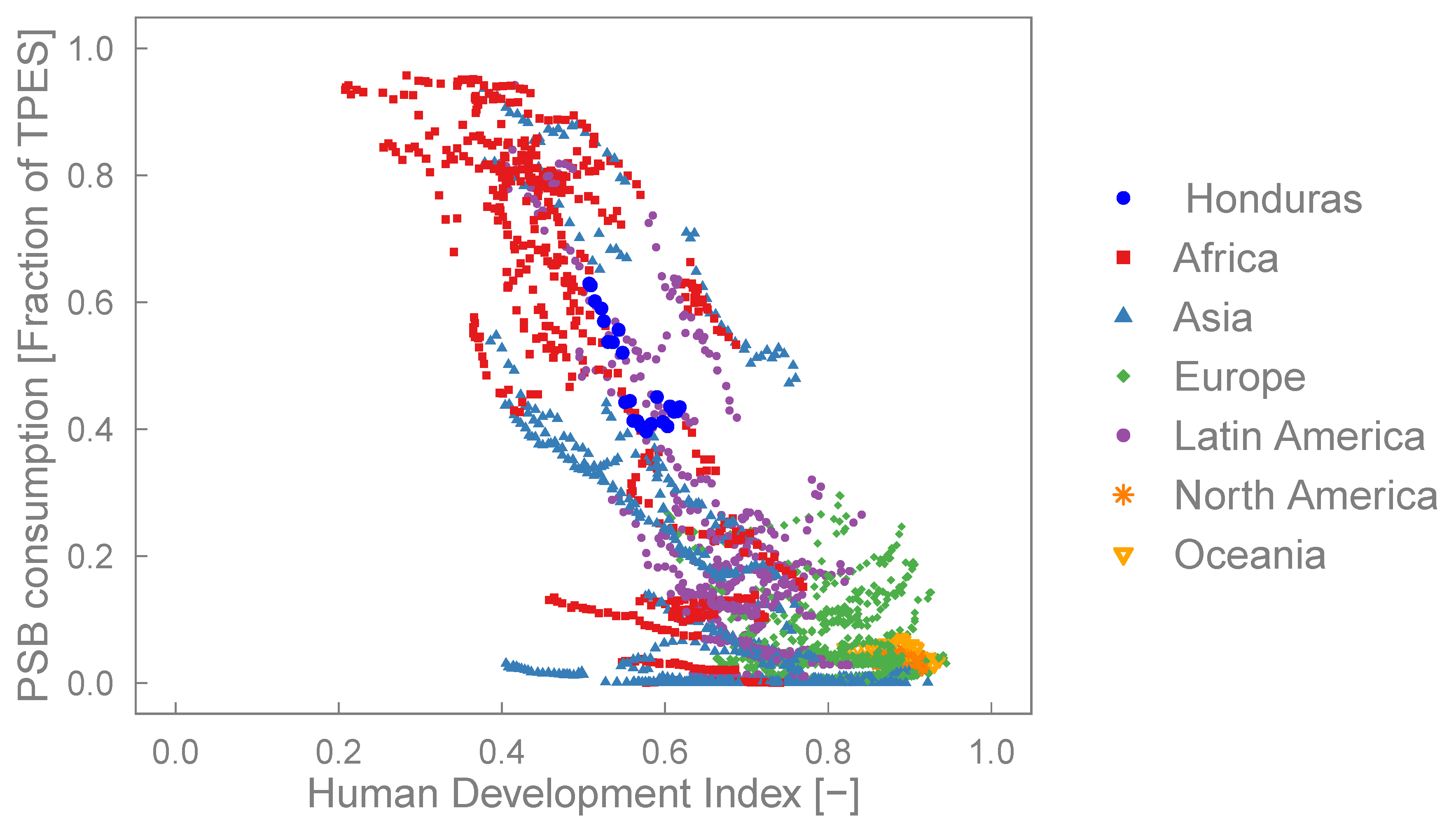
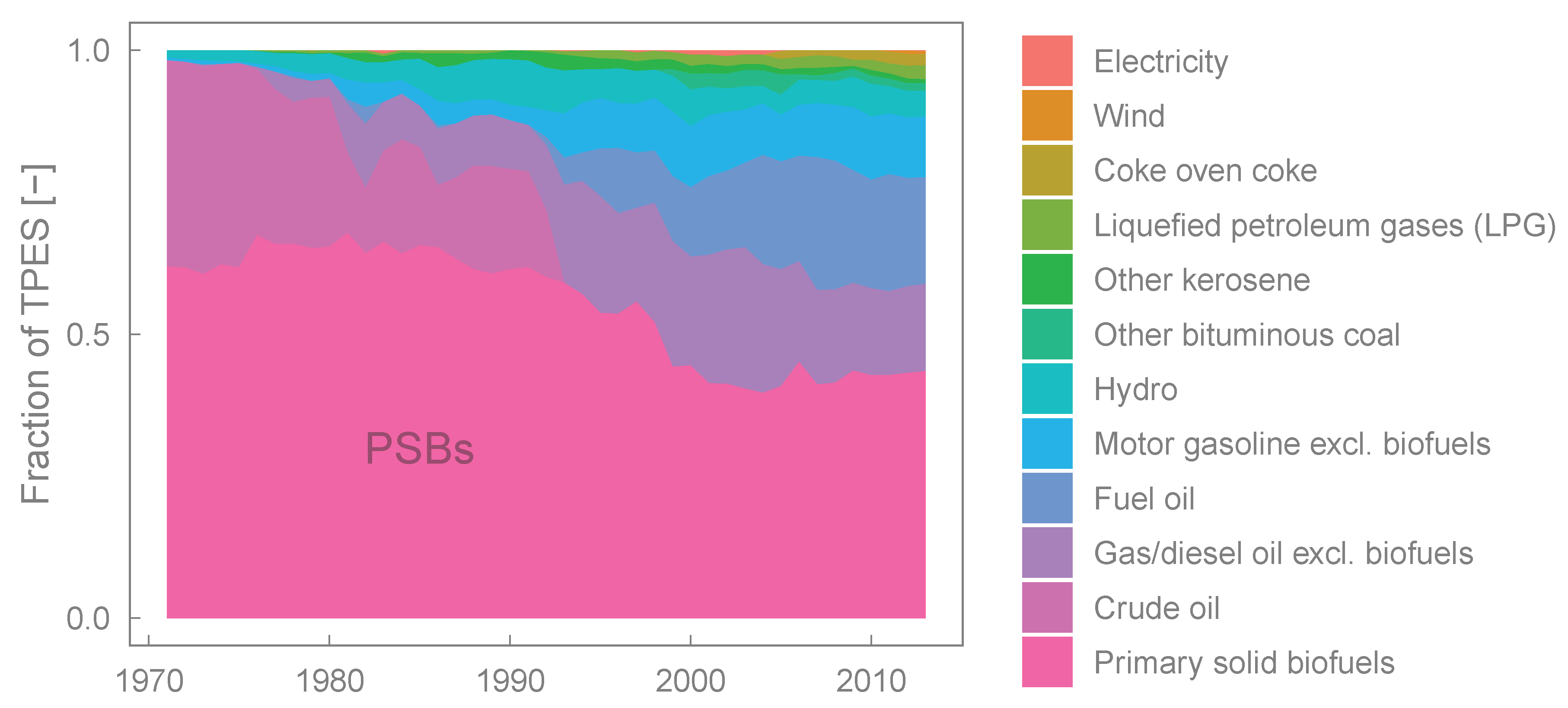
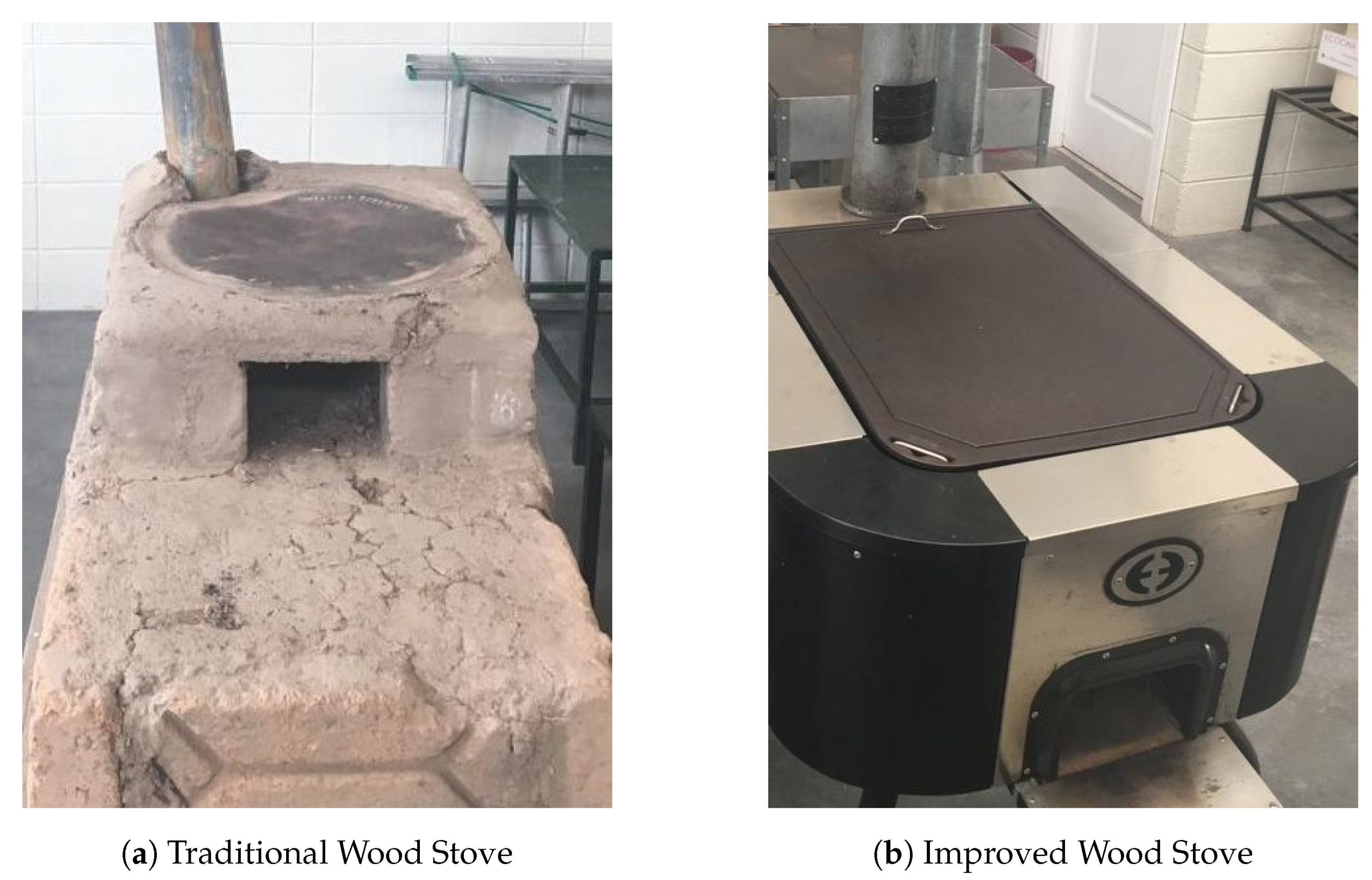
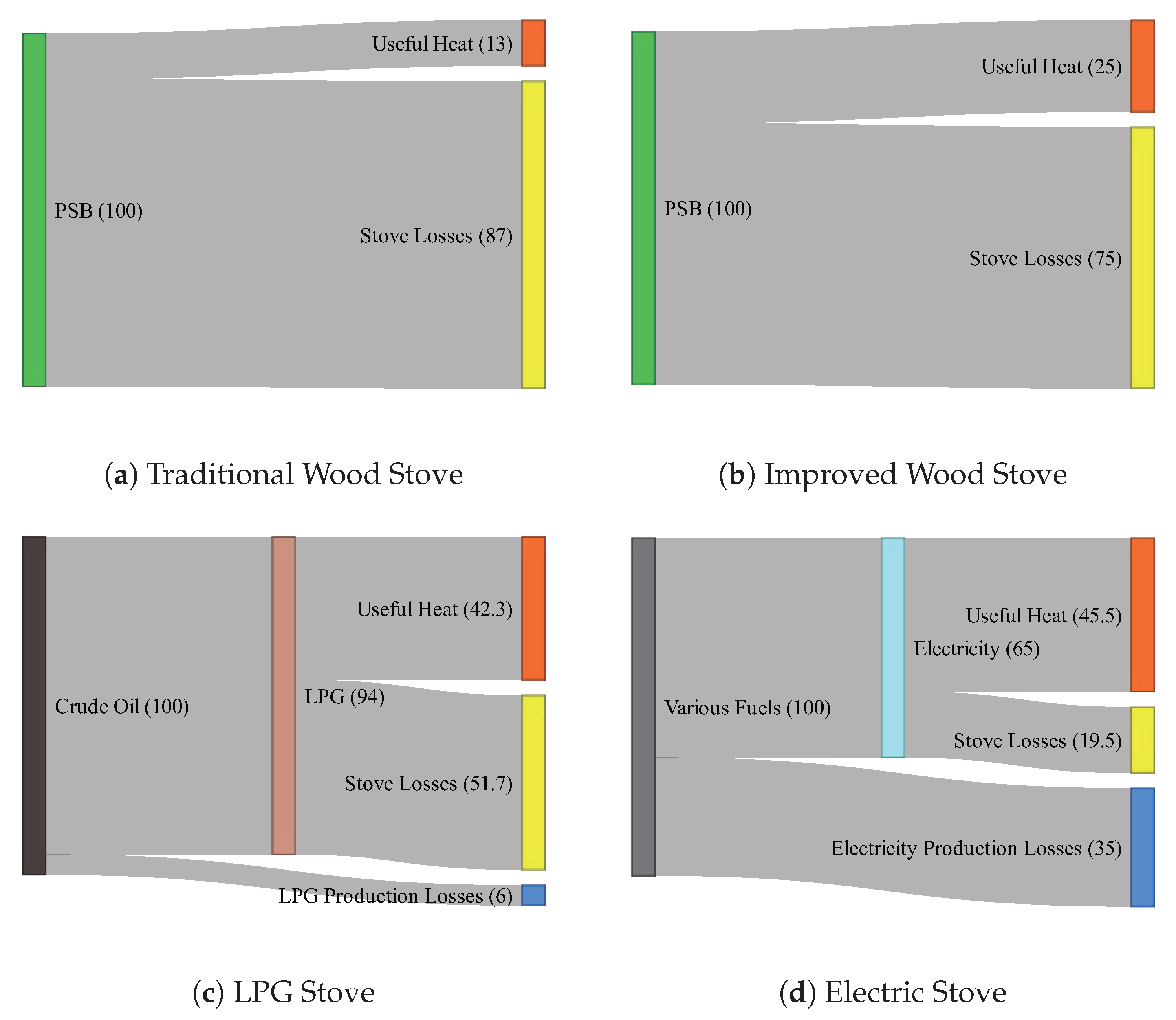

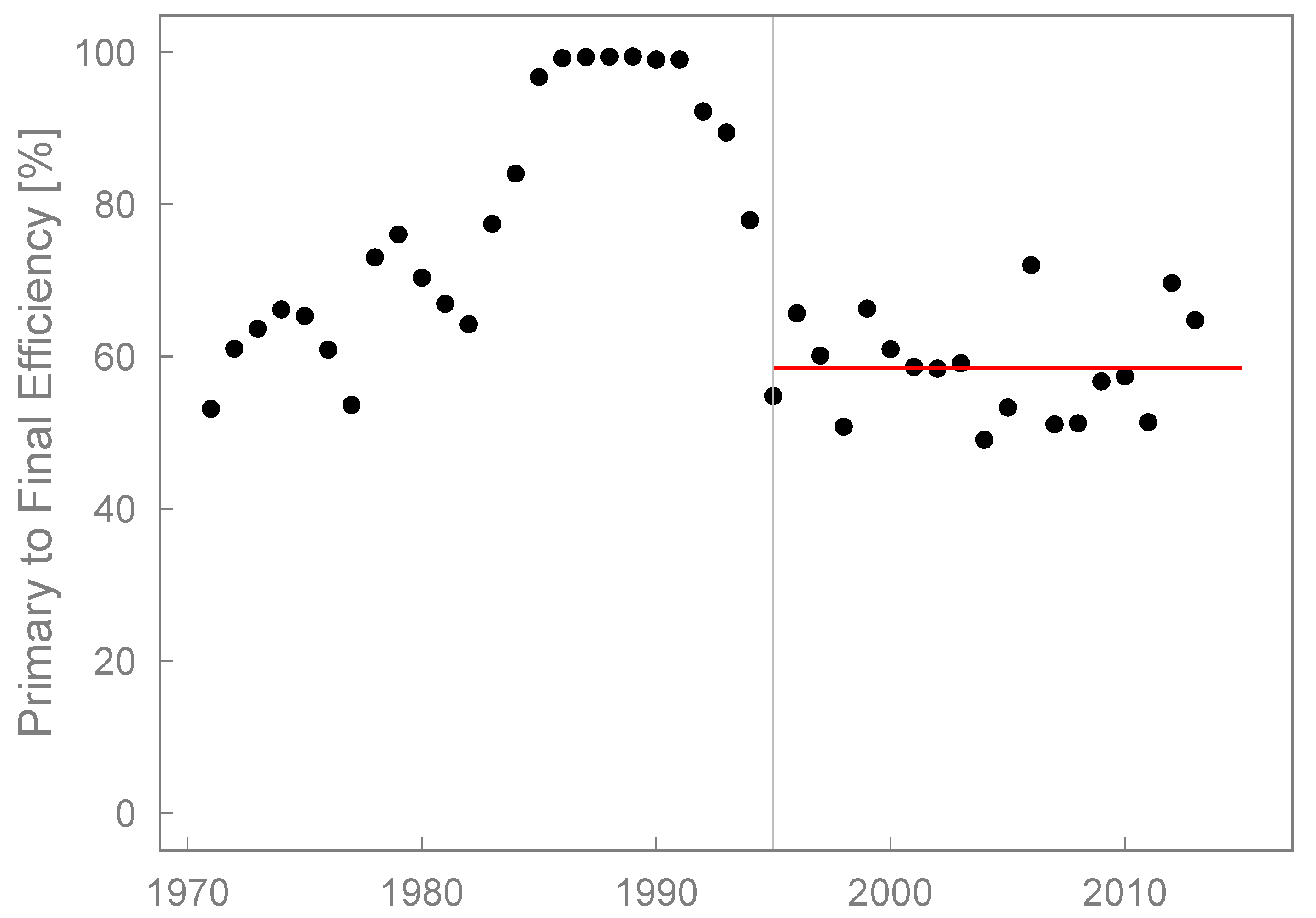

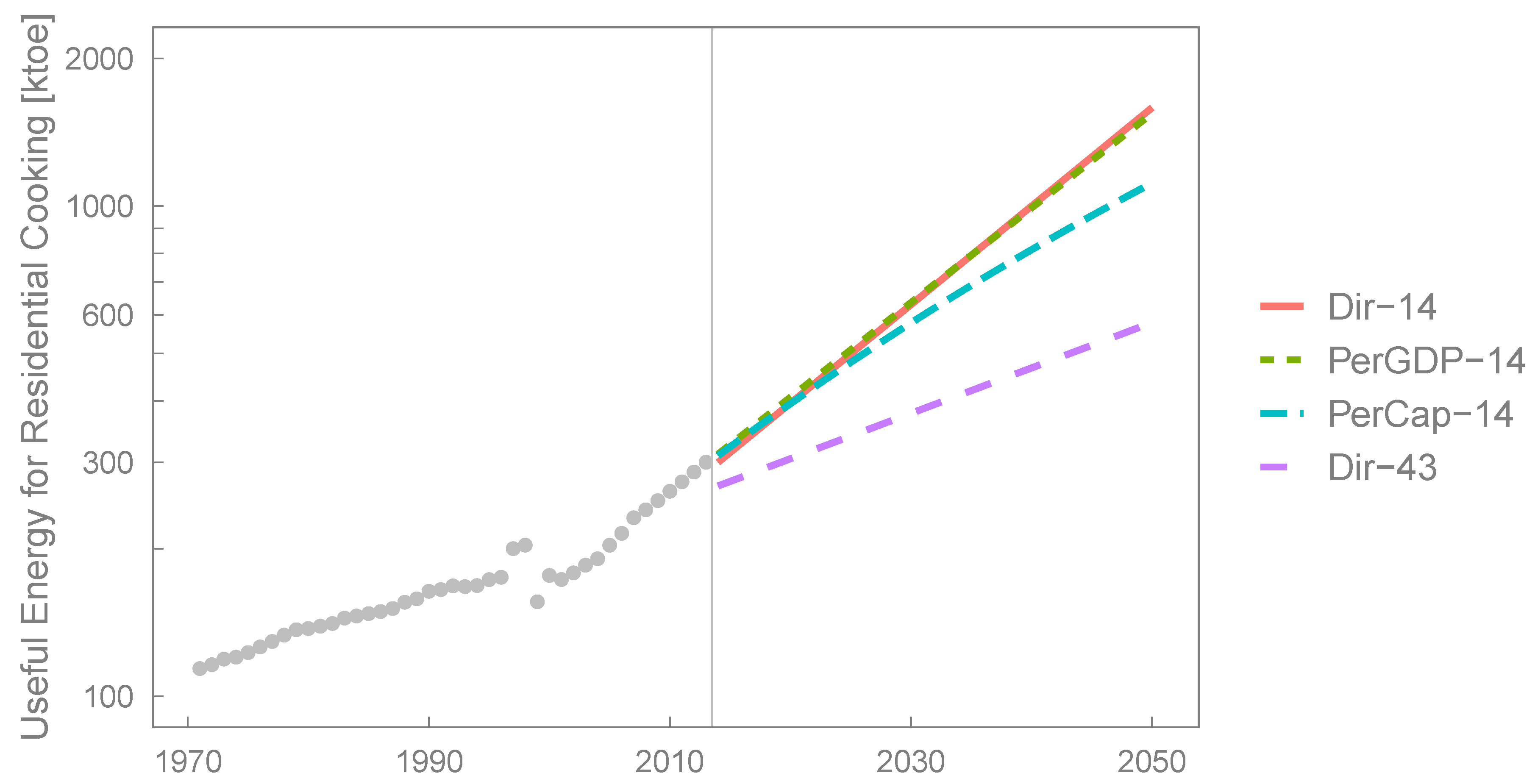
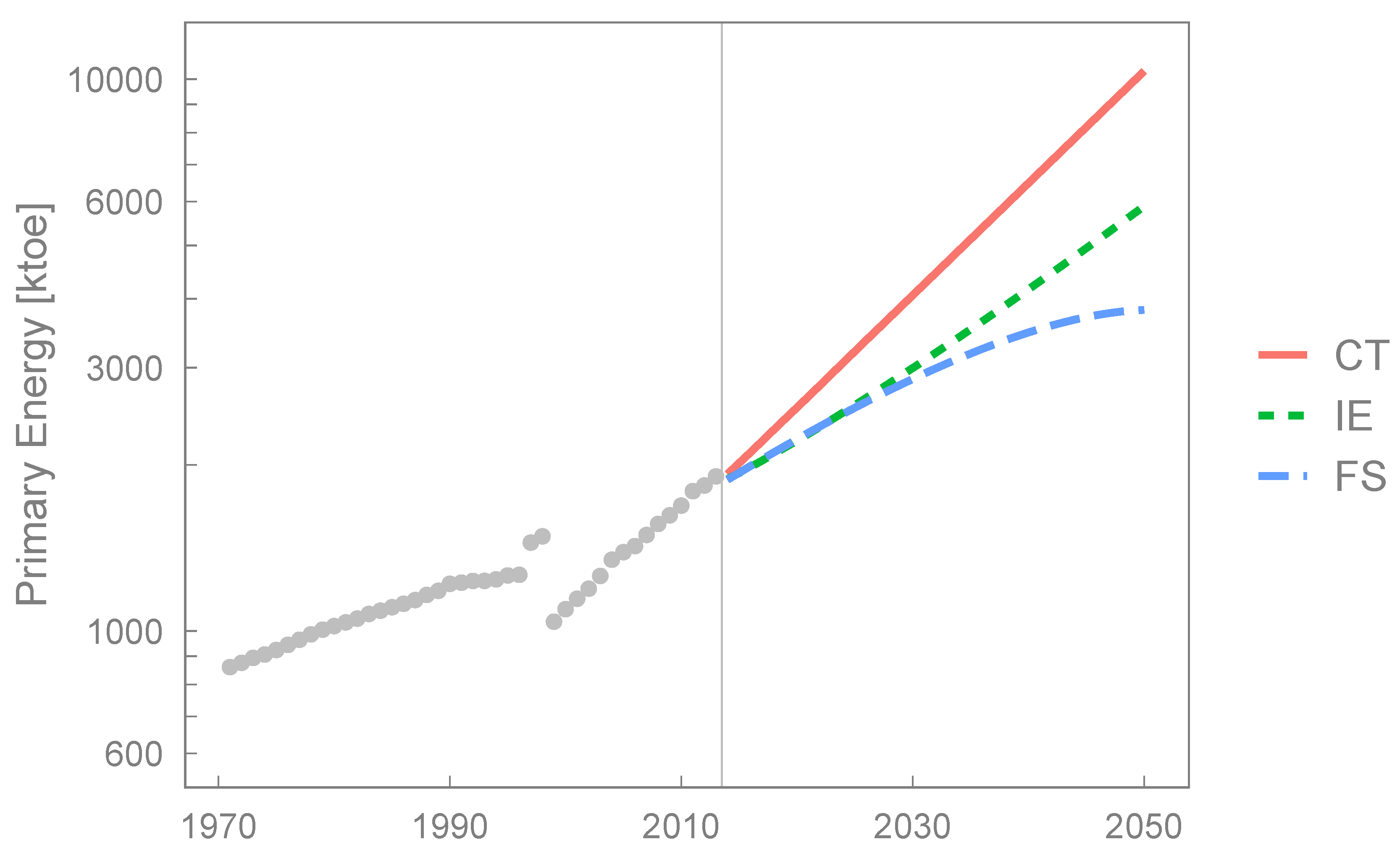

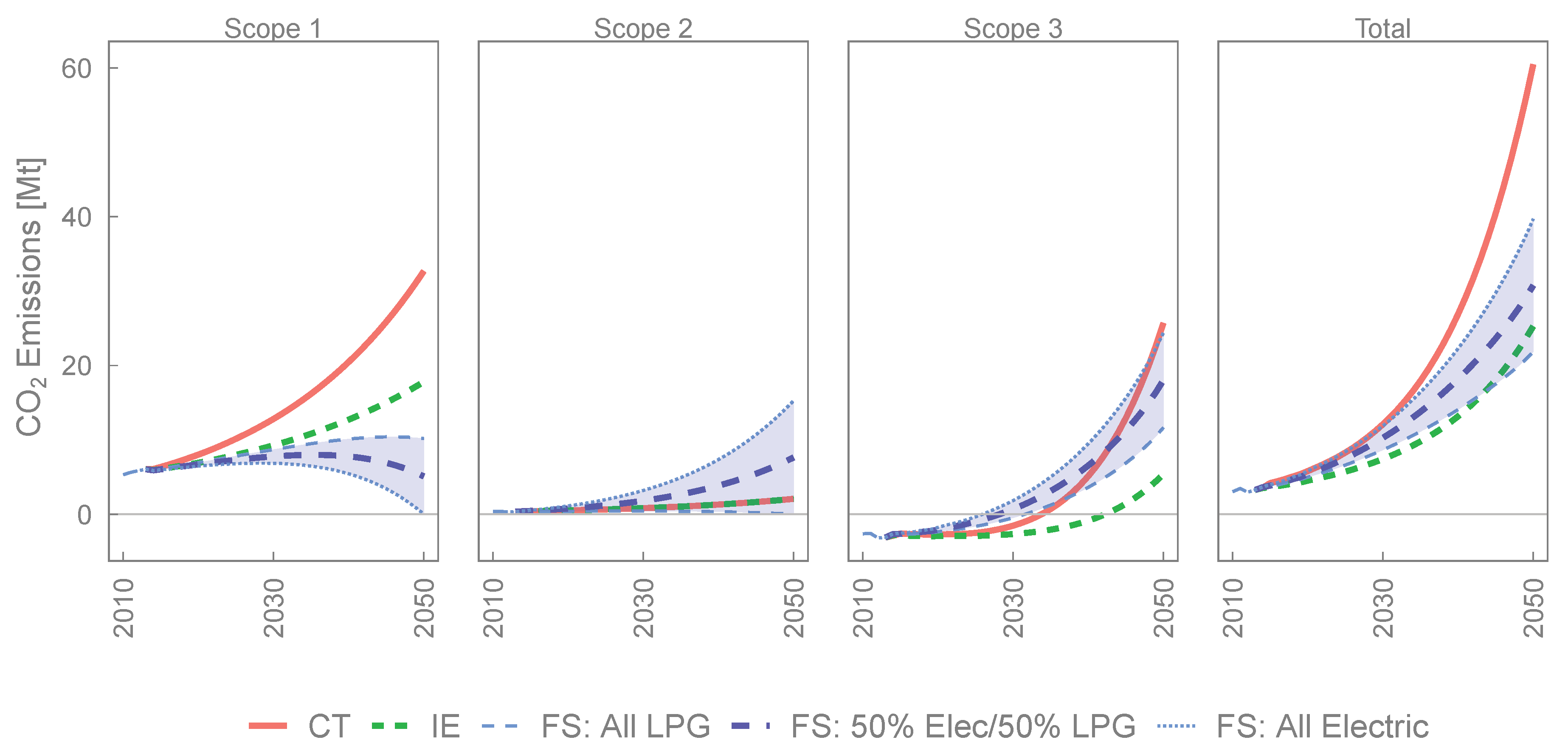
| Stove Type | Primary to Final (Production) Energy Efficiency | Final-to-Useful (Stove) Energy Efficiency |
|---|---|---|
| Charcoal | 30.7% [17] | 18% [37] |
| Kerosene | 93.7% | 37.8% [38] |
| LPG | 93.7% | 45% [37] |
| Electric | ∼58.5% | 70% |
| Traditional PSB | 100% | 13% |
| Improved PSB | 100% | 21% (2013) to 25% (assumed 2050) |
| Energy Source | Scope 1 | Scope 2 | Scope 3 |
|---|---|---|---|
| MT CO/ktoe | MT CO/ktoe | MT CO/ktoe | |
| Kerosene | 3154 | 0 | 2650 |
| LPG | 2704 | 0 | 3100 |
| PSB | 3977 | 0 | Varies |
| Electricity: Fuel Oil | 0 | 3240 | 5284 |
| Electricity: Gas/Diesel | 0 | 3100 | 5424 |
| Electricity: Hydroelectric | 0 | 0 | 302 |
| Electricity: Coal | 0 | 3960 | 6367 |
| Electricity: Wind | 0 | 0 | 302 |
| Electricity: Average | 0 | 2590 | 4531 |
© 2020 by the authors. Licensee MDPI, Basel, Switzerland. This article is an open access article distributed under the terms and conditions of the Creative Commons Attribution (CC BY) license (http://creativecommons.org/licenses/by/4.0/).
Share and Cite
Ver Beek, N.; Vindel, E.; Heun, M.K.; Brockway, P.E. Quantifying the Environmental Impacts of Cookstove Transitions: A Societal Exergy Analysis Based Model of Energy Consumption and Forest Stocks in Honduras. Energies 2020, 13, 3206. https://doi.org/10.3390/en13123206
Ver Beek N, Vindel E, Heun MK, Brockway PE. Quantifying the Environmental Impacts of Cookstove Transitions: A Societal Exergy Analysis Based Model of Energy Consumption and Forest Stocks in Honduras. Energies. 2020; 13(12):3206. https://doi.org/10.3390/en13123206
Chicago/Turabian StyleVer Beek, Noah, Elvin Vindel, Matthew Kuperus Heun, and Paul E. Brockway. 2020. "Quantifying the Environmental Impacts of Cookstove Transitions: A Societal Exergy Analysis Based Model of Energy Consumption and Forest Stocks in Honduras" Energies 13, no. 12: 3206. https://doi.org/10.3390/en13123206
APA StyleVer Beek, N., Vindel, E., Heun, M. K., & Brockway, P. E. (2020). Quantifying the Environmental Impacts of Cookstove Transitions: A Societal Exergy Analysis Based Model of Energy Consumption and Forest Stocks in Honduras. Energies, 13(12), 3206. https://doi.org/10.3390/en13123206








